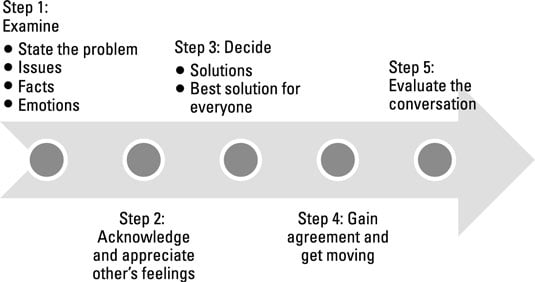Critical conversation skills can help you address a myriad of problems, including conflict. Like any good critical conversation, a conversation designed to help resolve conflict should follow a common process: examine the issue, options, and ideas; decide on solutions; and then get moving and evaluate the results of the conversation.
During staff disputes, the parties involved often need to spend more time appreciating others’ points of view. Although appreciating others’ feelings is part of other critical conversations, when you’re dealing with conflict, this step can’t be ignored or hidden within other agreements during conflict resolution.

Here’s how the five steps break down:
Identify the cause of the conflict
As the discussion begins, clearly state your reason for the meeting. Stating the purpose of the discussion helps set the tone for the rest of the conversation. Additionally, all the parties may be able to reduce some of the stress of the conversation by stating how they feel to one another.
Right after stating your own feelings, use an objective, non-confrontational statement to state why you feel this way. Just as in other critical conversations, this links a fact (what the other person is doing or saying), to a consequence (how it is making you feel). Be sure to:
Always use a friendly, polite tone. Even if there are waterworks in the room or someone is yelling or swearing like a sailor, stay professional.
Keep your emotional statements short and to the point. Going on and on about how you’re just so confused or how your dog died just muddies the water. Be clear and concise.
Appreciate the other person’s point of view
Often, conflict arises when people feel that their feelings and ideas aren’t being heard. Whether you’re the facilitator, initiator, or a party having the critical conversation, when parties disagree, that disagreement is often tied to another person’s ego.
If no one is acknowledging how other people feel during the conversation, the quality of the critical conversation and the results of the conversation most likely are going to be poor.
By appreciating another person’s point of view, you’re legitimizing that what you see or hear has value. “I hear your complaint,” or, “I can understand why you may feel betrayed,” acknowledges that the individual’s feeling is real. Note that appreciating another party’s point of view and agreeing with it aren’t the same thing.
Before moving on to the next step, ask whether everyone is willing to work together to resolve the issue. Think of this mutual agreement as a baby step toward solving the problem.
Decide on a solution most acceptable to everyone
If a staff dispute is out of control or if the parties have significant disagreements that may never be fully resolved, an alternative to 100 percent agreement is 100 percent acceptance. Although the conversation may not end with everyone going off into the sunset and working happily ever after together, the conflict can end with all parties being able to live with and support the decision and next steps.
If the conversation is about an employee talking loudly on their cellphone (even for work purposes), the conversations may never stop, but all parties may agree to live with having cellphone conversations in a designated area.
Gain commitment to get moving
When you’re resolving conflict, especially staff conflict, action needs to be quick after the conversation ends. Because most staff conflicts are based on emotions, you want to see an immediate change (within 24 to 48 hours) in behavior.
If you don’t see change that quickly, the parties in the conversation may start wondering if change will ever happen, which can start an entirely new set of emotions and conflict in the workplace. If actions need to take place, put together an action plan to make sure the decisions made during the conversation happen.
Evaluate results after the conversation
Evaluating the results of whether or not Sally and Jim like each other more or can agree to work together may not be as clear as asking an employee to improve sales performance or client retention, but it can and should be done. Simply say, “Let’s check in next week and see how these decisions are working,” and then check in a week later.

